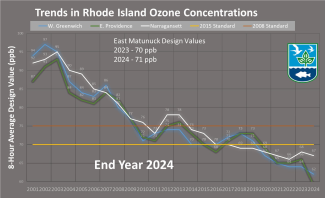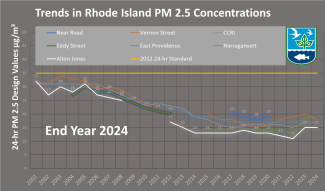Air Monitoring
RIDEM and the Rhode Island Department of Health (RIDOH) maintain a network of air monitoring sites in Rhode Island. Each site measures a variety of pollutants with specific monitoring objectives. For a deeper look at objectives, network, and upcoming network changes, view the latest Annual Monitoring Network Plan and 5 Year Network Assessment below:
Why monitor the air?
- To ensure the air Rhode Islander’s breath is safe, both for the short and long term.
- To track air quality over many years. It’s also important to identify air pollution control programs that are working and problem areas to focus more attention on.
- EPA has established National Ambient Air Quality Standards (NAAQS). Our data determines compliance with these Federal standards
Rhode Island Air Monitoring Locations
The pushpins on the below map represent each of our monitoring sites. Click on each pushpin for details.
Want details on the NAAQS? Visit EPA's NAAQS Table
Data and Trends
Curious to see Rhode Island air monitoring data for yourself? Running a data query is easy with EPA's Air Data webpage. Contact Darren Austin at 401-537-4385 or darren.austin@dem.ri.gov for questions on air quality data.
Ozone Trends – Rhode Island continues to experience several days during each spring and summer when ozone concentrations exceed the 2015 Federal Standard and reach UNHEALTHY on the Air Quality Index (AQI). However, the trend over the past 2 decades shows a marked improvement in ozone concentrations. Much of Rhode Island’s ozone problem can be attributed to transport of ozone and ozone precursors from more polluted upwind regions.

Although Rhode Island rarely exceeds the daily PM 2.5 Standard (particles with diameters 2.5 micrometers or smaller), there are several days each year when fine particles are elevated well into MODERATE on the AQI. There is also growing evidence that fine particles, smaller ultra-fine particles (UFP), and Air Toxics levels are much more elevated alongside major highways. For a deeper look at Near Road monitoring and mobile source emissions in Rhode Island, click here.
Overall, fine particle concentrations have also trended downward over the past couple decades due to improved vehicle fuel efficiency, lower vehicle emissions, decreases in the manufacturing sectors, and pollution mitigations programs.

Additional Resources
- Ozone Information
- AirNow
- AirNow: Rhode Island
- AirNow: Mobile App of Fire and Smoke Map
- EnviroFlash - Why go searching for the air quality forecast, when it can be sent to you....for free! Click to sign up. It's simple!
For further information, contact Darren Austin at 401-537-4404.
